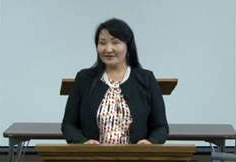Symposium 2014: Mongolia

Reported by Page Johnson
Moderator: Richard H. Page
Choinorov Sunrevtsoodol Khukhdandar
Prefacing her remarks with a quick overview of Mongolian topography and history, Choinorov Sunrevtsoodol Khukhdandar, senior official in the Ministry of Labor, discussed her country’s religious policy towards its population of 2.9 million. Of this group, 95% are Mongolian and 4.9 % are Kazakhs. One in every five Mongolians believes in traditional religion. A main theme of this paper is that as government policies and attitudes to religion have changed, religious beliefs have changed also. The present government is supportive of new religious developments if they positively affect the population.
Her introduction described a landlocked country of steppes and mountains, economically based on agriculture and extensive mineral deposits. She explained how her country’s policies relating to religious freedom have changed most dramatically in the modern era as the Mongolian government has changed. Under Soviet influence, the Mongolian People’s Republic was created in 1924, but with the dissolution of the Soviet Union, the Mongolians were able to create a Constitution in 1992 that includes a policy on human rights.
The history of religion in Mongolia centers primarily on Buddhism, which dates back to the 16th century. During the early 20th Century, however, the government placed restrictions on religious believers, especially monks. At least 70,000 monks were killed and others sent to prison or forced to deny their faith. Centuries of Buddhist temples were destroyed and the presenter’s own grandfather was killed during this purge. The end of the Soviet era made it possible to eliminate the hostility to religion, to accommodate a revival of Buddhism, and to open the doors to Christians and Muslims.
Minister Choinorov then presented extensive data showing changes in the population’s religious belief and affiliation. Early research studies asked respondents whether they would describe themselves as religious, but later ones probed further by asking individuals 15 years and older not only whether they were religious, but also the nature of their conviction. In a 2010 study, they found that 53% of Mongolians were Buddhist, 3% were Muslims, 2.1% were Christian, 2.9% were Shaman, and the rest subscribed to other faith traditions. A 2010 comparison of studies revealed that in 1994, 72% of the population said they believed in a religious faith. This increased to 79% by 2003, but decreased to 61% by 2010.
She suggested that the reasons for this decline include globalization, which she believes stimulates people to examine their faith and question the need for it. In addition, changes in social activities and the introduction of other faiths to the country have also affected the religious commitment and complexity of the country. She pointed out that today’s modern society has changed to include both traditional and non-traditional faiths, which present new doctrines and practices. At least 600 religious organizations have registered with the Mongolian government. A 2011 study of 25,000 people revealed a growing Christian population, of which 9% of the Christians were members of The Church of Jesus Christ of Latter-day Saints.
Darijav Naranbaatar
Mr. Darijav Naranbaatar, senior official at the Department of Immigration, did not make a formal presentation but did speak briefly during the question and answer period. He reaffirmed the government’s support of religious freedom and its intention and practice to fairly and expeditiously process visa-related requests from religious workers and organizations. Mr. Naranbaatar expressed his appreciation to the Center for the opportunity to participate and meet with the other delegates.